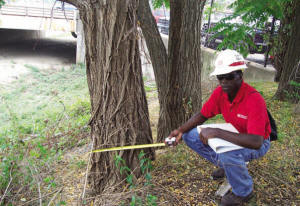 The following provides information concerning U.S. Army Corps of Engineers Vegetation Standards for Flood Damage Reduction Infrastructure.
The following provides information concerning U.S. Army Corps of Engineers Vegetation Standards for Flood Damage Reduction Infrastructure.
Background
- Public safety is the number one priority of the Corps' Levee Safety Program.
- Clear policies and standards, consistently applied and enforced, are critical components of the Corps' Levee Safety Program.
- In order to clarify and better communicate vegetation-management standards, the Corps has reviewed its national policy and standards and has developed Engineering Technical Letter (ETL) No. 1110-2-571 Guidelines for Landscape Planting and Vegetation Management at Levees, Floodwalls, Embankment Dams, and Appurtenant Structures.
- This Engineering Technical Letter does not establish new standards, but clarifies, and supersedes, those formerly presented in EM 1110-2-301 (Jan. 1, 2000).
- An Independent External Peer Review and Independent Technical Review (ITR) validated the Engineering Technical Letter based upon existing and available engineering and scientific data.
- The clarified standards outlined in the Engineering Technical Letter are mandatory: they apply to all flood damage reduction projects in the Corps’ program, and will be incorporated into applicable Levee Safety Program processes and guidance.
Next Steps
- Existing scientific literature does not conclusively validate or invalidate current Corps vegetation standards. The Corps is currently undertaking a two-year research program to enable reassessment of its engineering-based understanding of the public safety consequences of vegetation on flood damage reduction projects.
- Any change to current Corps vegetation management policy and standards will be based upon sound engineering and science, and will not adversely affect public safety.
- Independent Peer Review recommendations have been incorporated into the research plan; are being incorporated into the revision of vegetation variance policy and other guidance; and will be incorporated into any post-research updating of vegetation-management policy and standards.
- Public safety will remain the paramount consideration.
Key Points
- Fifteen feet is the minimally accepted vegetation free zone (VFZ) and is widely viewed as not sufficient for all projects. To date, no research exists to justify a reduction to existing standards.
- If an existing project easement (real estate interest) allows for less than 15 feet, the vegetation free zone shall be the maximum attainable within the existing real estate interest.
- The Engineering Technical Letter discusses a limited range of conditions under which a variance to vegetation standards may be granted. The variance request process is currently under revision and interim guidance is available through the Headquarters, U.S. Army Corps of Engineers Levee Safety Program Manager (LSPM). Public safety will not be compromised.
- The standards in the Engineering Technical Letter are not new, and the Corps has considered them critical to flood damage reduction project reliability for decades.
- The Engineering Technical Letter is available at: http://140.194.76.129/publications/eng-tech-ltrs/etl1110-2-571/toc.htm